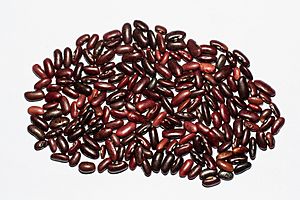Kidney bean facts for kids
| Nutritional value per 100 g (3.5 oz) | |
|---|---|
| Energy | 532 kJ (127 kcal) |
|
22.8 g
|
|
| Sugars | 0.32 g |
| Dietary fiber | 7.4 g |
|
0.50 g
|
|
|
Protein
|
8.67 g
|
| Vitamins | Quantity
%DV†
|
| Thiamine (B1) |
14%
0.16 mg |
| Riboflavin (B2) |
5%
0.058 mg |
| Niacin (B3) |
4%
0.578 mg |
| Vitamin B6 |
9%
0.12 mg |
| Folate (B9) |
33%
130 μg |
| Vitamin C |
1%
1.2 mg |
| Vitamin E |
0%
0.03 mg |
| Vitamin K |
8%
8.4 μg |
| Minerals | Quantity
%DV†
|
| Calcium |
3%
28 mg |
| Iron |
23%
2.94 mg |
| Magnesium |
13%
45 mg |
| Potassium |
13%
403 mg |
| Sodium |
0%
2 mg |
| Zinc |
11%
1.07 mg |
| Other constituents | Quantity |
| Water | 66.94 |
|
Link to USDA Database entry
|
|
| †Percentages estimated using US recommendations for adults. | |
The kidney bean is a popular type of bean. It's known for its kidney-like shape and reddish-brown color. These beans are a big part of meals all around the world. They are often used in dishes like chili con carne and salads. Kidney beans are also super healthy, packed with good stuff for your body.
Contents
What Are Kidney Beans?
Kidney beans are a variety of the common bean (Phaseolus vulgaris). They belong to the legume family. This family includes other well-known foods like peas, lentils, and peanuts. Legumes are plants that grow their seeds in pods.
Why the Name "Kidney"?
The name "kidney bean" comes from its unique shape. It looks very much like a human kidney. This makes them easy to spot among other types of beans. They usually have a deep red or reddish-brown color.
Where Do They Come From?
Kidney beans first grew in the Americas. People have been eating them for thousands of years. They were an important food for ancient civilizations. Today, they are grown in many countries. India, Brazil, and the United States are some of the top producers.
Cooking and Eating Kidney Beans
Kidney beans are a very versatile food. This means they can be used in many different dishes. They are a main ingredient in chili con carne. In India, they are used to make a popular dish called Rajma. You can also find them in soups, stews, and cold salads.
Important: Always Cook Them!
It is very important to know that raw kidney beans are not safe to eat. They contain a natural toxin called phytohaemagglutinin. This toxin can make you sick if you eat raw or undercooked beans.
To make them safe, you must cook them properly.
- First, soak dried kidney beans in water for at least 8 hours.
- Then, drain the water and rinse the beans well.
- Finally, boil them in fresh water for at least 10 minutes. After boiling, you can simmer them until they are tender.
Canned kidney beans are already cooked and safe to eat. Just rinse them before using.
Why Are They Good For You?
Kidney beans are a nutritional powerhouse. They offer many benefits for your health.
- Protein: They are a great source of plant-based protein. This is important for building and repairing your body.
- Fiber: They are high in dietary fiber. Fiber helps your digestion and keeps your gut healthy. It can also help you feel full longer.
- Vitamins and Minerals: Kidney beans contain many important vitamins and minerals. These include iron, magnesium, potassium, and folate. Iron helps carry oxygen in your blood. Magnesium is good for your muscles and nerves.
Eating kidney beans can help keep your heart healthy. They can also help manage blood sugar levels. This makes them a smart choice for a balanced diet.
Images for kids



